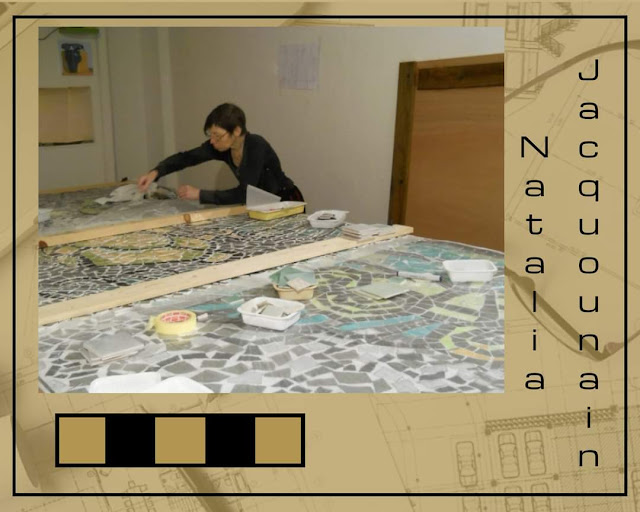Natalia Jacquounain captures and synthesises the miracle of light-written by Maria Marchese
zoomonart.blogspot.com
Contemporary art
and culture
Natalia Jacquounain captures
and synthesises the miracle of light
Curated by Maria Marchese
Natalia Jacquounain was born in Russia, but in the mid-1980s, she decided to leave her homeland for France, thus reconnecting with an approach to art that was, for her, more 'colourful' and lively than the Russian one. Since the 1970s, she has been pursuing an aesthetic path consisting of painstaking studies: still lifes are a fertile incipit, which evolves, over time, into increasingly complex compositional research and implementation; they are gradually enriched and brought up to date, until they detach themselves from the canvases and become selected and uncommon sculptural acts. The skull of a horse, purchased in that early period, opens a season that sees her exhibiting in various French galleries: the choice of such an unusual subject is indicative of an unconventional analytical mind. She then drew on some engravings by Hogarth, an important 18th century English artist and intellectual, which she realised in the "Violoncelle Noir" and "Violons d'automne" series. The commitment spent on each of these different acquaintances materialises and consolidates, in the years to follow, as new aesthetic experiences arise; in 2015, on the occasion of an exhibition at Cloître des Billettes, Natalia Jacquounain flanks the two aforementioned series with the "Narcisse" series. Then, from the 1980s onwards, the artist produced a series of landscapes and still lifes, which make explicit her need to give voice to space on her canvases: these reflect an experimentation that seals her performing skills. Progressively, the study of the mathematical bases of perspective led her to the creation of objects in volume: sculptures to be placed or hung. Volumes never completely abandon the material supports either, and various aesthetic florileges come to life: "Lutece", "Foret urbain", "Gothicus", "Fauselle", "The roofs of Monmartre as a game of weights and counterweights", "Lockdown or World in the Other Dimension", "Confinement", up to the newly born "Meta - ecology". The plastic side of Natalia Jacquounain represents, in my opinion, a period deserving of great attention: from calculation, unexpectedly, the artist builds full profiles, which illuminate details and human, social, natural contexts..., grasped in their mutability, preserving, at last, poetry and lightness.
Eclat Festival
As far as we can discern, the only purpose of human existence is to shine a light into the darkness of mere being.
In "Eclat festival", Natalia Jacquounain seems to grasp the highest significance of the concept, expressed by the philosopher: with acuity, in fact, she synthesises the plastic truth of a radiance, both physical and intellectual, baptising the incipit of an existential summer.
"Bang": the artist clicks the trigger and, an instant later, it is back in place, as the shot pierces the air.
Or, again.
"Click": Natalia Jacquounain presses her finger on the button of a photographic device and, lightning-fast, the flash appears, then disappears, while, inside, humours are released from a pod, sealing, immediately, the profiles of an instant.
Or...
The author bends her arm, in whose hand a golf club is gripped, backwards, then moves it, in a calibrated but decisive manner, forwards, until the head hits the ball, which hovers, upwards, cutting off the surrounding breath, and then falls back to the ground.
A triadic imagery penetrates Natalia Jacquounain's creative temperament, contorting it.
At first, the artist is enraptured by that intuition, 'so that the desire to confess it, to the human eye, changes into restlessness and intellectual turmoil: sound, light, smells, movement, speed, lines, shapes... then, they swarm, in her mind, marry and abandon, bounce, stop, stretch and relax...
Thus, this whirling succession of thoughts appears and disappears, intermittently.
The scenographer's analytical eye identifies, therefore, all the real elements of that brief theatrical act, but it is not enough for her; she searches, in geometry and calculation, for the roots, in order to concretise the philosophy of that incipit, as fleeting as it is rapacious and fascinating, which then matures into a reflective study.
The brevity of the lapse of time, to which she wants to give life, clashes with the depth of that theorēma, which is meditation and observation, tangible and not, subtility does it with universality, then, d'emblèe, Natalia Jacquounain finds the right compromise: the palm schematises the environmental behavioural and emotional tension, on paper, after which, she undermines the infinitesimal erratic reality, characterising, through the realisation of parallelograms and triangles, which intersect and tilt, the space/time diastema, in which that 'festival', that lively dancing feast of luminous energy, experiences itself, as a spherical presence, softening, indeed, the rigour of the composition.
Natalia Jacquounain shatters the banality of the everyday event in order to involve it, at last, in artistic/existential architectures, which testify to a qualitative leap in the international art scene.
The work is part of the series "Hanging Sculptures".




Commenti
Posta un commento